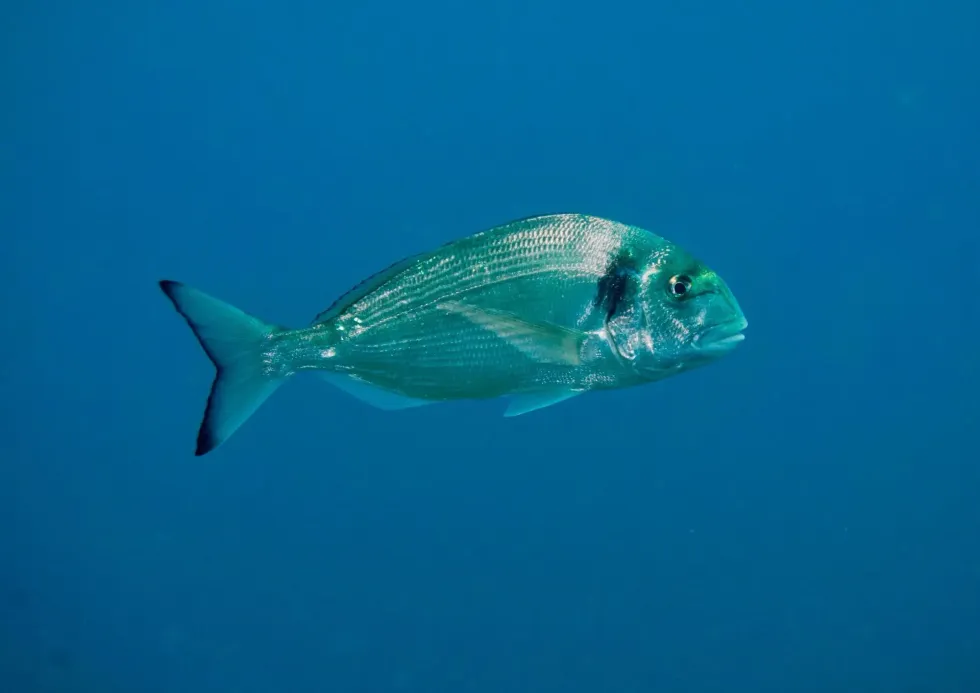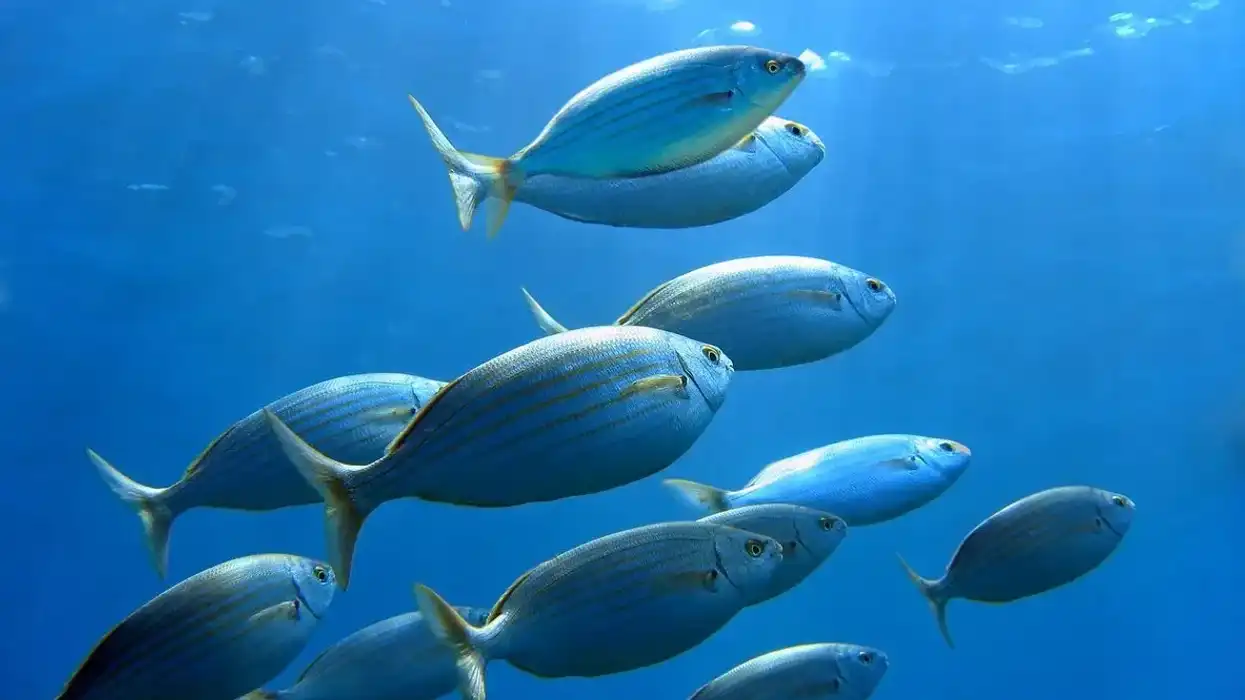Are you interested to know about more fishes from the Sparidae family like the mahi-mahi? If yes, then hop on as we are going to learn about an interesting fish species.
The gilt-head seabream or Sparus aurata is a sea fish found in the eastern Atlantic as well as in and around the Mediterranean Sea. This type of bream has a silvery body, but it's mostly known for the gold bar present between its eyes.
It is often raised in fisheries for human consumption, and people also enjoy fishing these breams. It's enjoyed as a delicacy in different European countries like Greece, Italy, and Spain.
The reproduction system of this fish is quite interesting as the bream first develops as a male, and after a couple of years, it turns into a female to spawn.
Want to know more about this bream species? Keep reading for interesting gilt-head seabream. For more relatable content, check out these grass carp facts and common carp facts for kids.
Gilt-Head Seabream Interesting Facts
What type of animal is gilt-head seabream?
The gilt-head seabream (Sparus aurata), also known as the Orata, is a type of bream belonging to the family Sparidae.
What class of animal does gilt-head seabream belong to?
The gilthead seabream belongs to the class Actinopterygii. The gilthead seabream is also the only species in the genus Sparus.
How many gilt-head seabreams are there in the world?
As the gilt-head seabream is a popular part of fish productions for human consumption, we cannot really put a number to its population.
Where does gilt-head seabream live?
The Sparus aurata is mainly found in the coastal areas of the eastern Atlantic and in the Mediterranean Sea. It has also been reported to be found in the Black Sea. But, we don't know if this seabream is endemic to a particular place.
What is a gilt-head seabream's habitat?
The habitat of this fish includes marine and brackish environments. It is usually found in sandy bottoms and seagrass beds, usually at a depth of not more than 98.4 ft (30 m). The temperature of a waterbody is important for this fish, and a group of these breams often move towards estuaries and lagoons during spring.
Who does gilt-head seabream live with?
In an aquaculture farm or hatcheries, you can find the gilthead seabream fish kept together in the same pond. However, as a wild fish, it can either be solitary or move around in small groups.
How long does gilt-head seabream live?
In the wild, the gilthead seabream can survive for 11 years. However, as it's widely consumed by humans, often young fishes are caught during fishing. Often farmed fishes are caught as the bream reaches the age of 16 months.
How do they reproduce?
The most interesting part of these breams from the Sparidae family is the system of reproduction. Most eggs develop into male fishes, but at around the age of three years, males turn into females to start spawning. This phenomenon makes this sea bream a protandric hermaphrodite fish.
Generally, the spawning happens between the months of October-December, and females may lay around 20,000-80,000 eggs in a day. Several clutches can be produced in the length of four months.
Under the right temperatures, the hatchlings can come out in only 48 hours. Rather than natural spawning, fisheries prefer the intensive system. The young are often fed on a high protein diet for faster growth.
What is their conservation status?
According to the International Union for Conservation of Nature Red List, the gilthead sea bream is placed under the classification of Least Concern.
Gilt-Head Seabream Fun Facts
What does gilt-head seabream look like?
The gilthead seabream has a deeply compressed oval body with a curve in its head. This fish has a slightly oblique and low mouth with protruding lips and small eyes.
Around 73-85 scales are present on the lateral line, and scales are also present on the cheek. The body is of a silvery gray color, and a large black patch can be seen extending from the lateral line to its opercle.
However, the most interesting thing about this bream fish is the golden line or band present between the eyes, and it's enclosed with dark areas. Because of this golden band, the fish is called the gilt-head seabream. Dark lines are also seen on the body, the dorsal fin, and the caudal or tail fin.
How cute are they?
Unlike the beautiful parrotfish, we wouldn't really call the gilt-head bream a cute fish species, but its shiny dazzling body does look eye-catching.
How do they communicate?
When it comes to this marine fish species, we are yet to know a lot about it. However, fishes are usually known for having amazing ways of communication, which often include gestures and motions.
Some fishes also communicate via electrical pulses. When it comes to the gilt-head bream, its visual senses matter the most, and the fish can adapt to seeing in different water environments.
How big is gilt-head seabream?
The average body length range of the gilthead seabream is around 13-15.7 in (33-40 cm). However, there are instances where the gilt-head bream has achieved a length of up to 27.6 in (70 cm). Compared to it, the redbreast sunfish has a size of around 8-12 in (20.3-30.5 cm).
How fast can a gilt-head seabream swim?
The burst swimming speed of the gilthead seabream has been said to be 1.1 mph (1.8 kph).
How much does gilt-head seabream weigh?
The average weight range of the gilthead seabream can go up to 16.2 lb (7.3 kg).
What are the male and female names of the species?
There are no separate names for male and female of this marine fish species.
What would you call a baby gilt-head seabream?
A baby gilt-head seabream can be called a fry.
What do they eat?
The gilthead seabream has an omnivorous diet, and they mainly scour the bottom of a waterbody in search of crustaceans, mollusks, polychaetes, and echinoderms. This species is especially fond of shellfish. Along with aquatic animals, this fish also feeds on plant matter, and as juveniles, its main form of food is zooplankton.
Are they dangerous?
No, this isn't a dangerous fish, and it is widely eaten by humans.
Would they make a good pet?
This fish is usually just for consumption purposes.
Did you know...
In 2018, the estimated production of the Sparus aurata from the Sparidae family was thought to be around 224,966 ton (228,576 met ton). It's also one of the most produced fishes reared around the Mediterranean Sea.
Even though this fish is known as Orata in Italy, the people of Spain know it as the Dorada, and in France as Dorade.
Is gilt head bream healthy?
Yes, the gild-head bream is a healthy fish, and people do love to eat it because of its taste and nutrition. It's especially a popular fish in Mediterranean cooking. Moreover, this fish is also a good source of B vitamins.
What is the most unhealthy fish to eat?
Tilapia is considered to be one of the most unhealthy fishes that one can consume. The foremost reason being the circumstances of raising the fish, which is often in an enclosed area.
Moreover, the fish also has a reputation of being a food item through which humans can get mercury poisoning.
Even though tilapia originated in the Middle East and Africa, the fish is now farmed and available all over the world. Compared to it, the rainbow trout is considered to be one of the healthiest fishes for human consumption.
Here at Kidadl, we have carefully created lots of interesting family-friendly animal facts for everyone to discover! For more relatable content, check out these codfish interesting facts and black marlin fun facts pages.
You can even occupy yourself at home by coloring in one of our free printable tropical fish coloring pages.
Second image by Roberto Pillon.









